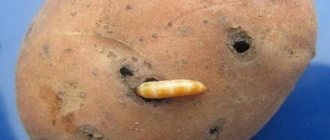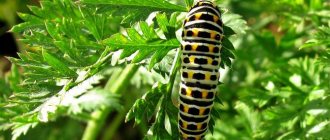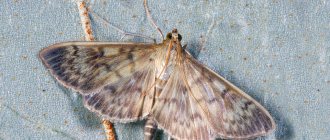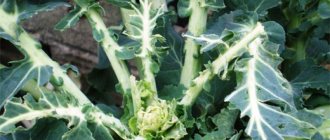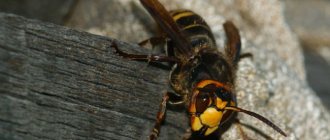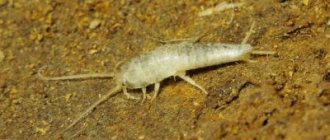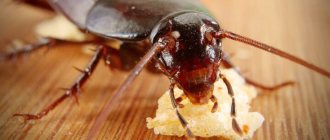Ognevki - a big family
Moths belong to the Lepidoptera family. There are 6,000 species of these butterflies on earth. And almost all of them are considered pests to one degree or another. Some of the moths harm plants, others are the most terrible parasite that destroys bee colonies.
Most moths are butterflies that fly in the evenings or at night
The moth can be found in all corners of the earth - both in warm and cold climates. Hundreds of species of moths live in Russia. But only some of them pose a particular danger to agriculture.
The lifespan of a butterfly is 3 months. Each moth lays up to hundreds of eggs per season.
Wax moth
Our list of the most common types of moths begins with representatives of the family Galleria mellonella - the large wax moth and Achroia grisella - the small wax moth. These insects are conventionally united under one name: bee moth. It is one of the most dangerous pests of honey bees and is widespread wherever beekeeping flourishes.
Description
A sexually mature moth (wax moth) is a butterfly with a wingspan of about 3.4 cm and a body length of 1.8 to 3.8 cm. Like all representatives of this family, this insect has two pairs of wings: the front ones are gray-brown, covered dark spots and with a yellowish-brown edging; the hind ones have a lighter shade. Females are larger than males.
The eggs are whitish in color and size 0.5x0.35 mm. Embryonic development lasts from 5 to 8 days, after which larvae emerge from the eggs. They live in hives and feed on wax. The first instar larva has 4 pairs of legs. The size of its body is no more than 1 cm. Over time, the caterpillar increases in size, and the length of its body can reach 1.8 cm. The color of the head also changes: from light yellow to brown.
On a note! Over the entire period of its development, one bee moth larva can damage several hundred wax cells!
The larval phase lasts from 25 to 30 days, after which the caterpillars hide in secluded places, for example, in crevices, cracks, or in independently gnawed holes, where they pupate. During its development, the pupa changes its original yellow color to a darker brown. Subsequently, adult butterflies emerge from the cocoons. The lifespan of fledged females is 8-12 days, males - 10-26 days.
Maliciousness
Bee moth larvae feed on honey and beebread, and as they mature, they change their diet and begin to consume wax honeycombs, along with parts of the cocoons remaining there. In addition, in the process of moving, the caterpillars entangle the passages with their silk threads. During the life of the parasite, not only the cells are damaged, but also the frames, the material that served to insulate the hives, and the brood, and the volumes of honey and bee bread are rapidly decreasing.
When overcrowded, bee moth caterpillars begin to lack food and eat each other or larvae from the previous litter. When this parasite appears, bee colonies noticeably weaken. Sometimes the bees leave the hive, but most of them always die.
Benefit
In folk medicine, a tincture based on the larvae of this type of moth is widely known and quite actively used. This remedy has proven itself very well in the treatment of tuberculosis, diseases of joint tissue, atherosclerosis, oncology and other pathologies.
Plus, during a unique experiment, it was proven that wax moth caterpillars have a unique ability to decompose polyethylene: after 40 minutes, the larvae left several holes in a plastic bag, and in 12 hours, 100 individuals were able to absorb 92 mg of this material. Moreover, bee moth caterpillars not only eat polyethylene, but also decompose it. This is facilitated by hemogenate, which is in the body of the larvae, and as a result of plastic processing, ethylene glycol is formed.
Harm
The majority of moth species are considered particularly dangerous pests. They are notable for the fact that they colonize granaries, food warehouses, elevators and destroy stocks of fruit crops, grains, and cereals.
Moths are dangerous pests of food products and also destroy crops of fruit and agricultural plants.
A number of moths settle in warehouses and infect confectionery products, flour, and dried fruits. Having settled in shops and warehouses, moths can cause multimillion-dollar losses. Therefore, at the first sign of the appearance of a moth, it is necessary to take all measures to destroy it.
What pests are there?
When talking about food moths, as a rule, we mean the grain moth, without identifying the differences, and it can be identified by spoiled products - cereals, groceries, nuts. In fact, there are different types of moths, which, although similar to each other, have their own specifics.
The following main types of moths can be distinguished:
- The mill moth is less common. It is less conspicuous, having a rather nondescript color.
- Flour moth (flour moth) is the most common pest in common kitchens in both rural and urban areas.
- The southern barn moth (moth) has a beautiful, original pattern on its wings. It is the most difficult to deal with.
- The cocoa moth is common and is very similar to the box moth. It has an inconspicuous slightly yellowish tint to the wings.
In general, it is difficult to distinguish the food moth from the clothing variety, and therefore a conclusion is drawn about the insect based on its habitat. Other types of moths are accepted in everyday life - classified according to their preferred food. That is why concepts such as cereal, nut, pea and other moths are used. The cereal variety is found in buckwheat, millet, rice, etc., and the nut variety is found inside the nut.
Insect larvae are very voracious
Mill fire
It arrived in Russia from India and spread everywhere. Mainly settles in mills, flour mills, bakeries and other places where grain is processed. Feeds:
- flour products,
- grain,
- cereal,
- pasta,
- dried fruits,
- mushrooms,
- nuts,
- confectionery products.
The mill moth reaches a size of 14 mm and has dark gray wings with dots and stripes. The moth lives 20 days, during which it is capable of laying 200 eggs. The butterfly can live in warm warehouses all year round. 7 generations of pests are hatched per year.
Adult millet moth
The moth not only destroys the grain, but also pollutes it with the products of its vital activity and the cobwebs it produces. We advise you to read the article about methods of combating chestnut leaf miner.
Nutrition of mill moth caterpillars
Barn moth
The mill moth is a pest of grain, dried fruit, confectionery and flour products. Together with such granary pests as grain moths, grain beetles, granary weevils and other insect pests, the mill moth is capable of destroying a large supply of grain by gnawing out the embryos.
There is a difference in the size and timing of metamorphosis not only depending on air temperature. The southern barn moth, which develops in dry fruits, berries and fruits, is much larger in size than the one that feeds on flour.
Southern barn moth
Just like the miller moth, it prefers to destroy grain, confectionery, nuts, and dried fruits. Most often found in the southern regions of the country.
The moth is small in size - 7-9 mm - and is distinguished by a dirty white-yellow color with a dark pattern on the wings. Butterflies live for two weeks.
Moths clog grains and produce with the web tubes they create. They pose a particular danger to granaries, where they destroy seed embryos. As a result, seed germination is lost.
The southern granary moth lives in granaries, mills, elevators, etc. (in the upper layers of the embankment at a depth of 15 cm)
The moth is afraid of low temperatures and dies already at a temperature of +14 degrees. Therefore, one of the ways to successfully combat it is to store food and grain at temperatures below 14 degrees.
Types of moths
Among the many species that threaten grain harvests and food supplies, moths stand out for their harmfulness. Insects of the family Pyralidae are small butterflies with a thin body and long limbs. Their front wings are triangular in shape, 2-3 times longer than wide. The hind wings are wider and shorter than the front ones. Like other lepidopteran butterflies and moths, grain pests are classified as fully metamorphosed insects. This development involves the passage of four stages: egg, larva, pupa, adult.
The larvae, called caterpillars, have underdeveloped abdominal legs and gnawing-type mouthparts. Special glands secrete a substance that solidifies into a web when exposed to air.
Information. Moth moths do not feed; despite common misconceptions, they do not fly towards the light.
Insects at the larval stage damage stocks of cereals and flour in home kitchens, stores and industrial storage facilities. Among the most common types:
Mill moth
The butterfly is 10-14 mm long, the wing size is up to 24 mm. The front wings are gray with black wavy stripes, the hind wings are white. The insect prefers to feed on flour and is most often found in mills. The pest is found in grain and flour processing plants around the globe. The female lays 250-300 eggs, attaching them to bags or walls of the room. The caterpillar creates a web tube; it does not tolerate sunlight. Most of the larvae live and develop in the upper layer of flour, deepening by 5-10 cm. In the middle zone, 2 generations are replaced per year, in the south - 6-7. As preventive measures, disinfestation of storage facilities, treatment of grain with contact insecticides, and cooling (heating) of grain processing products are recommended.
Grain moth
A polyphagous pest, it is called seed, tobacco, cocoa and chocolate. Its length is 7-8 mm, wingspan is 15-17 mm. The forewings are gray-ashy, with light bands and dark scales. Insects are ubiquitous. The female lays 100 to 200 eggs. It takes 5 days for the embryo to mature. The color of the larva depends on the type of food; it can be white, yellowish or pink. The length of the caterpillar is 12-15 mm. The development of one generation takes 2-6 months, depending on the ambient temperature. The larvae feed on grain, sunflower seeds, flour, chocolate, and cereals. Adult caterpillars are resistant to cold, young ones die at -100 after three days.
This butterfly has many names - seed butterfly, tobacco butterfly, chocolate butterfly and others.
Flour moth
The butterfly is medium in size, its body is up to 12 mm long, its wingspan is 20-30 mm. The insect is distinguished by its variegated color - at the base and at the top they are red-brown. The basic tone changes from olive to brown. The butterfly often bends its abdomen upward. The pest is widespread everywhere except the far north. In Mongolia, Hungary, and Cuba it is a quarantine facility. The female produces up to 250 eggs. The caterpillars are off-white. They damage cereals, grains, flour and flour products. The larvae live in colonies, each creating a tube for itself from cobwebs and food. This is a cold-resistant species. In summer, butterflies live outside, scattering among houses and storage areas.
Southern barn moth
A common species called the Indian moth. The insects live in North America, throughout Europe, Asia and Australia. The butterfly's body size is 7-8 mm, its wings are 14-20 mm. The fore wings are narrow, yellowish at the base, then reddish-ochre. Two dark gray stripes cross the wings. The length of the caterpillar is 12-16 mm, it is devoid of bristles.
The color of the larvae is yellowish or greenish. The caterpillars damage grain and flour, preferring corn flour. They are found in confectionery factories, where they damage chocolate, as well as almonds and other nuts. The larvae are dangerous for seeds; they primarily gnaw out the embryo. The insect is a heat-loving species and stops developing at temperatures below 140.
Flour moth
It is distributed almost everywhere and affects granaries, warehouses, confectionery factories, shops, and flour mills.
Female flour moth
Like all the other types of moths listed above, it feeds on grain, cereals, seeds, and confectionery.
The size of the flour moth is quite large - the wings reach a size of 12-30 mm. The color of the wings is light brown with a dark pattern.
Field moth
This type of moth is found everywhere, but the most numerous and most harmful in woodlands and forest-steppe
It is a pest of fields. Prefers crops:
- radishes;
- cabbage;
- beets;
- horseradish;
- celery;
- spinach;
- rapeseed
This is a fairly large butterfly measuring 24 mm and yellow-brown in color. The main damage is caused by moth caterpillars that eat the leaves of cultivated plants. The main sign of damage to the field moth is holes in the leaves.
Plowing the soil before sowing and in the fall, destroying weeds and regularly loosening the soil helps protect crops from the field moth.
Cruciferous scorched moth
Adult cruciferous scorched moth
This moth prefers to attack cruciferous plants:
- radish;
- cabbage;
- rape;
- turnip.
These are light yellow butterflies measuring almost 20-28 mm. The butterflies emerge twice during the summer; at the end of August, the caterpillars burrow into the ground for the winter.
To successfully fight the moth, you need to dig up the ground in the fall and destroy weeds that are a natural wintering site.
Cabbage moth
Cabbage moth is familiar to many gardeners. The larvae of this type of insect appear around May and June and eat cabbage leaves. By the end of June, the development of this stage ends, the caterpillars go into the soil, where they pupate. The butterflies fly in August, they lay eggs on the lower surface of the leaves of the same cabbage and weeds, and in the fall the second generation emerges from them, which overwinters in the soil and pupates in the spring of next year. In this case, the ovipositor period can be greatly extended - up to a month, sometimes longer.
Description
The cabbage moth butterfly has a wingspan of about 2.5-2.6 cm. The front pair is painted dirty yellow, the pattern is composed of two brownish stripes, between which there is a spot. The hind pair of wings is light yellow.
Cabbage moth butterfly
The cabbage moth larva is a caterpillar whose color changes from light yellow to yellow-green as it develops. The body size of a young larva is approximately 2 cm, an adult – 3 cm. There are two light, clearly visible stripes on the back. The head is light brown.
Maliciousness
The damage is caused by the larvae, which, having hatched from the eggs, begin to “scrape” the lower surface of the leaf blades, but no through holes are formed. As the caterpillars grow, they cause more and more noticeable damage, and older individuals can already gnaw out holes. In addition to cabbage, the diet of cabbage moth larvae also includes beets and horseradish.
Destruction
To destroy moths, spraying with insecticides, irradiation with insecticidal lamps and fumigation are used.
In small farms, spraying with solutions of tobacco and wormwood is used.
An effective remedy for fireweed
If the moth gets into the house and settles in the products in the kitchen, destroying them, then you can use Raptor traps, insecticidal plants - laurel, lavender, geranium, citrus peel, wormwood. All cabinets should be washed with a solution of vinegar and wormwood and lavender should be placed in them. This will scare away the moth.
The fire damages both large farms and small kitchens, destroying food supplies and turning them into dust. Therefore, it is necessary to fight it regularly, leaving the butterflies no chance of survival.
Folk remedies
For some housewives, it is extremely important to know how to get rid of food moths without spoiling the food? Everything is simple here. If you are afraid to use chemicals against food pests, then be sure to pay attention to folk remedies for food moths.
Ingredients for folk remedies
There are a lot of them and they are in no way inferior in effectiveness to more dangerous chemicals. So, in the fight against moths they will help you:
- Lavender bags. Make small cloth bags with drawstring ties and fill them to the top with fresh or dried lavender. Place this craft in a closet where food moths have infested. The butterfly does not tolerate the smell of the essential plant and will try to find a safer habitat for itself by leaving your home. By the way, lavender essential oil is now sold in pharmacies, which can also be used to fight moths and their larvae. Just soak a cotton swab in ether, roll it into a ball and place the structure in places where parasites accumulate.
- Garlic-based seasonings. If you peel garlic cloves and cut them into slices, and then place them on a plate and place them in a kitchen cabinet in which moths have infested, the pest will quickly leave its habitat, unable to bear the pungent odor. The advantage of garlic is that it can be placed directly into flour affected by moth larvae. The garlic smell will not be transferred to the grocery store, but it will help drive away moths.
- Orange peels. The sharp aroma of citrus will repel food moths from cabinets and containers with bulk products in the kitchen. However, it should be remembered that old zest does not emit a strong aroma, and therefore the crusts must be changed periodically.
- Mint. Surprisingly, the aroma of mint, pleasant to people, becomes a deterrent to food moths. In the summer, you can hang mint tied in bunches in the kitchen to dry - this will help prevent the appearance of harmful insects that spoil food.
- Rosemary - this plant also has a very unpleasant and pungent odor that repels pest butterflies. If you don’t want food moths to appear in your kitchen, just start growing a spice called rosemary there. The plant does not require special care and feels great in ordinary flower pots. Rosemary belongs to the category of perennials, and therefore it can be planted once and then simply cared for for many years. The fragrant leaves will be an excellent seasoning for your dishes, and in addition to eating, rosemary can be placed next to dry food. Scented geranium has a similar effect. Also place a pot of it in the kitchen if you are afraid of an invasion of food moths.
- Forest herbs. Collections of tansy, wild rosemary, and wormwood, thoroughly dried and folded into bags, will help remove not only moths, but also bedbugs and flies from the kitchen. Small bouquets are made from these herbs and placed in kitchen cabinets. However, do not forget that wild rosemary is a poisonous plant, and therefore should not be placed near food. And the aroma of wild rosemary has a bad effect on the human body, causing severe headaches.
- Bay leaf is a plant that also belongs to the esters and has a pungent odor. Of course, fresh laurel branches will give the best effect in the fight against food moths, but if there are none, you can replace them with dried bay leaves, sold in every grocery store.
- Camphor. The pungent smell of essential camphor oil or even camphor alcohol (which is sold in pharmacies) will drive food moths out of your kitchen for a long time. The internal surfaces of the cabinets in which the contaminated products were stored are wiped with camphor alcohol. For this purpose, the drug is first diluted with water in a 1:1 ratio. You can also soak cotton pads in camphor and place them in cabinets. As the aroma of the ether wears off, the cotton pads should be changed.
- Walnuts. Another effective remedy against food moths is the walnut, or rather its leaves. They should be placed throughout the kitchen, as well as in cabinets where cereals are stored. The insect cannot stand the smell of fresh nut leaves and flies away. But for effective control, do not forget to periodically replace wilted nut leaves with new, freshly picked ones.
- A mixture of vinegar and laundry soap. In the fight against food moths, a good remedy is laundry soap dissolved in water with the addition of vinegar essence. This composition should be used to wipe all kitchen surfaces daily. This method of eliminating moths is classic, but at the same time very effective.
- Perfume components. Food moths do not tolerate the smell of perfumes, especially floral or cheap ones.
